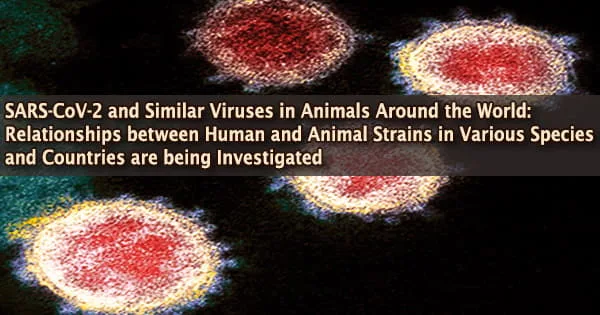A genetic and geographic examination of SARS-CoV-2, the virus that causes COVID-19 and related viruses in humans and animals, could reveal evidence of broad interspecies transmission. Dr. Ariful Islam of the EcoHealth Alliance and the Bangladesh Institute of Epidemiology, Disease Control, and Research, as well as colleagues, published their findings in the open-access journal PLOS ONE on December 15th.
Coronavirus disease 19 is caused by a virus that produces a respiratory ailment (COVID-19). SARS-CoV-2 is a coronavirus, which is a broad family of viruses. People and some animals can be infected by these viruses. SARS-CoV-2 was first discovered infecting humans in 2019.
Droplets emitted when an infected person coughs, sneezes, or talks are thought to spread the virus from person to person. It can also be spread by touching a virus-infected surface and then touching one’s lips, nose, or eyes, however, this is rare.
COVID-19 is being studied, as is the prevention of SARS-CoV-2 infection. Coronavirus 2 is also known as severe acute respiratory syndrome coronavirus 2.
SARS-CoV-2 is thought to have evolved through genetic variations among closely related viruses in horseshoe bats, according to a previous study. According to reports, the virus can transmit from humans to both domestic and wild animals (known as spillback).
However, much more research is needed on the epidemiology, evolutionary dynamics, and genetic links of SARS-CoV-2 and kindred viruses in animals all over the world.
Dr. Islam and colleagues analyzed the genome sequences of SARS-CoV-2-related viruses discovered in bats and pangolins, as well as SARS-CoV-2 strains found in a number of species around the world, including dogs, cats, and lions, to provide fresh insights.
SARS-CoV-2 strains detected in animals are closely related to SARS-CoV-2 strains found in humans in the same geographic regions, including Germany, France, Spain, and Denmark, indicating that human-to-human transmission has happened globally.
Spillover and spillback of SARS-CoV-2 has been proved, and the mutant strain of the virus is still dominating. It is our responsibility not to destroy the natural habitats of wildlife. As bats play an important role in maintaining a healthy ecosystem, we need to work on how to live safely with bats. We should not wait until the next pandemic, and we need to apply the One Health approach to secure a healthier future for the world.
Dr. Ariful Islam
If the virus spreads to animal hosts, that animal species could become a SARS-CoV-2 reservoir in the future. The researchers also calculated how often genetic changes linked to important SARS-CoV-2 subtypes and variations are in various animal species around the globe.
Multiple developing variants of concern, such as the Alpha, Delta, and Mu-variants, were discovered in dogs, gorillas, lions, and cats across many nations, and these variants shared significant genetic similarities with human SARS-CoV-2 sequences.
Cats and American mink, for example, were often infected with the GR clade of virus (31.6 percent and 49.7% of samples, respectively), which is also common in humans, indicating that interspecies transmission is likely.
The majority of dogs, however, were impacted by a distinct subtype, clade O (66.7 percent), which the authors believe suggests that clade O has a special affinity for dogs. Only 2.6 percent of cat and 4.8 percent of dog samples had the SARS-CoV-2 Alpha form, but 66.7 percent of gorilla and 77.3 percent of lion samples did.
Their genomic study revealed a high degree of resemblance between SARS-CoV-2 and related viruses found in a variety of horseshoe bat species, as well as a high degree of similarity between SARS-CoV-2 and related viruses identified in the Malayan pangolin.
The findings back with the theory that SARS-CoV-2 evolved from closely similar bat viruses that recombined genetically, and that the virus also spread through pangolins.
SARS-CoV-2 appears to be transmissible to animals, which could aid in its spread. As a result of their findings, the researchers recommend that SARS-CoV-2 in animals be genetically monitored in the future.
They also advocate for the vaccination of pets, zoo animals, and farm animals, as well as the prevention of contact between infected humans and animals. To detect and prevent the emergence of future viruses, the researchers advise regular surveillance at the human-animal interface.
The authors add: “Spillover and spillback of SARS-CoV-2 has been proved, and the mutant strain of the virus is still dominating. It is our responsibility not to destroy the natural habitats of wildlife.”
“As bats play an important role in maintaining a healthy ecosystem, we need to work on how to live safely with bats. We should not wait until the next pandemic, and we need to apply the One Health approach to secure a healthier future for the world.”
















